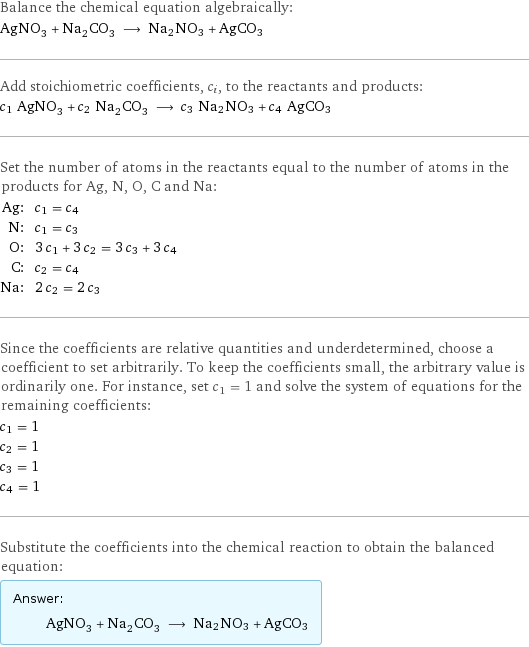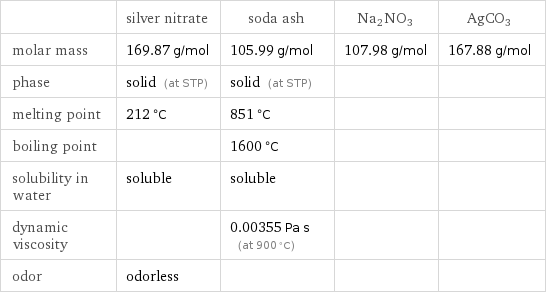Input interpretation

AgNO_3 silver nitrate + Na_2CO_3 soda ash ⟶ Na2NO3 + AgCO3
Balanced equation

Balance the chemical equation algebraically: AgNO_3 + Na_2CO_3 ⟶ Na2NO3 + AgCO3 Add stoichiometric coefficients, c_i, to the reactants and products: c_1 AgNO_3 + c_2 Na_2CO_3 ⟶ c_3 Na2NO3 + c_4 AgCO3 Set the number of atoms in the reactants equal to the number of atoms in the products for Ag, N, O, C and Na: Ag: | c_1 = c_4 N: | c_1 = c_3 O: | 3 c_1 + 3 c_2 = 3 c_3 + 3 c_4 C: | c_2 = c_4 Na: | 2 c_2 = 2 c_3 Since the coefficients are relative quantities and underdetermined, choose a coefficient to set arbitrarily. To keep the coefficients small, the arbitrary value is ordinarily one. For instance, set c_1 = 1 and solve the system of equations for the remaining coefficients: c_1 = 1 c_2 = 1 c_3 = 1 c_4 = 1 Substitute the coefficients into the chemical reaction to obtain the balanced equation: Answer: | | AgNO_3 + Na_2CO_3 ⟶ Na2NO3 + AgCO3
Structures

+ ⟶ Na2NO3 + AgCO3
Names

silver nitrate + soda ash ⟶ Na2NO3 + AgCO3
Equilibrium constant
![Construct the equilibrium constant, K, expression for: AgNO_3 + Na_2CO_3 ⟶ Na2NO3 + AgCO3 Plan: • Balance the chemical equation. • Determine the stoichiometric numbers. • Assemble the activity expression for each chemical species. • Use the activity expressions to build the equilibrium constant expression. Write the balanced chemical equation: AgNO_3 + Na_2CO_3 ⟶ Na2NO3 + AgCO3 Assign stoichiometric numbers, ν_i, using the stoichiometric coefficients, c_i, from the balanced chemical equation in the following manner: ν_i = -c_i for reactants and ν_i = c_i for products: chemical species | c_i | ν_i AgNO_3 | 1 | -1 Na_2CO_3 | 1 | -1 Na2NO3 | 1 | 1 AgCO3 | 1 | 1 Assemble the activity expressions accounting for the state of matter and ν_i: chemical species | c_i | ν_i | activity expression AgNO_3 | 1 | -1 | ([AgNO3])^(-1) Na_2CO_3 | 1 | -1 | ([Na2CO3])^(-1) Na2NO3 | 1 | 1 | [Na2NO3] AgCO3 | 1 | 1 | [AgCO3] The equilibrium constant symbol in the concentration basis is: K_c Mulitply the activity expressions to arrive at the K_c expression: Answer: | | K_c = ([AgNO3])^(-1) ([Na2CO3])^(-1) [Na2NO3] [AgCO3] = ([Na2NO3] [AgCO3])/([AgNO3] [Na2CO3])](../image_source/cdb069ede97cdc8e843f261ef7b6ca94.png)
Construct the equilibrium constant, K, expression for: AgNO_3 + Na_2CO_3 ⟶ Na2NO3 + AgCO3 Plan: • Balance the chemical equation. • Determine the stoichiometric numbers. • Assemble the activity expression for each chemical species. • Use the activity expressions to build the equilibrium constant expression. Write the balanced chemical equation: AgNO_3 + Na_2CO_3 ⟶ Na2NO3 + AgCO3 Assign stoichiometric numbers, ν_i, using the stoichiometric coefficients, c_i, from the balanced chemical equation in the following manner: ν_i = -c_i for reactants and ν_i = c_i for products: chemical species | c_i | ν_i AgNO_3 | 1 | -1 Na_2CO_3 | 1 | -1 Na2NO3 | 1 | 1 AgCO3 | 1 | 1 Assemble the activity expressions accounting for the state of matter and ν_i: chemical species | c_i | ν_i | activity expression AgNO_3 | 1 | -1 | ([AgNO3])^(-1) Na_2CO_3 | 1 | -1 | ([Na2CO3])^(-1) Na2NO3 | 1 | 1 | [Na2NO3] AgCO3 | 1 | 1 | [AgCO3] The equilibrium constant symbol in the concentration basis is: K_c Mulitply the activity expressions to arrive at the K_c expression: Answer: | | K_c = ([AgNO3])^(-1) ([Na2CO3])^(-1) [Na2NO3] [AgCO3] = ([Na2NO3] [AgCO3])/([AgNO3] [Na2CO3])
Rate of reaction
![Construct the rate of reaction expression for: AgNO_3 + Na_2CO_3 ⟶ Na2NO3 + AgCO3 Plan: • Balance the chemical equation. • Determine the stoichiometric numbers. • Assemble the rate term for each chemical species. • Write the rate of reaction expression. Write the balanced chemical equation: AgNO_3 + Na_2CO_3 ⟶ Na2NO3 + AgCO3 Assign stoichiometric numbers, ν_i, using the stoichiometric coefficients, c_i, from the balanced chemical equation in the following manner: ν_i = -c_i for reactants and ν_i = c_i for products: chemical species | c_i | ν_i AgNO_3 | 1 | -1 Na_2CO_3 | 1 | -1 Na2NO3 | 1 | 1 AgCO3 | 1 | 1 The rate term for each chemical species, B_i, is 1/ν_i(Δ[B_i])/(Δt) where [B_i] is the amount concentration and t is time: chemical species | c_i | ν_i | rate term AgNO_3 | 1 | -1 | -(Δ[AgNO3])/(Δt) Na_2CO_3 | 1 | -1 | -(Δ[Na2CO3])/(Δt) Na2NO3 | 1 | 1 | (Δ[Na2NO3])/(Δt) AgCO3 | 1 | 1 | (Δ[AgCO3])/(Δt) (for infinitesimal rate of change, replace Δ with d) Set the rate terms equal to each other to arrive at the rate expression: Answer: | | rate = -(Δ[AgNO3])/(Δt) = -(Δ[Na2CO3])/(Δt) = (Δ[Na2NO3])/(Δt) = (Δ[AgCO3])/(Δt) (assuming constant volume and no accumulation of intermediates or side products)](../image_source/093acca35e5b01b6ba490ae808b9c59e.png)
Construct the rate of reaction expression for: AgNO_3 + Na_2CO_3 ⟶ Na2NO3 + AgCO3 Plan: • Balance the chemical equation. • Determine the stoichiometric numbers. • Assemble the rate term for each chemical species. • Write the rate of reaction expression. Write the balanced chemical equation: AgNO_3 + Na_2CO_3 ⟶ Na2NO3 + AgCO3 Assign stoichiometric numbers, ν_i, using the stoichiometric coefficients, c_i, from the balanced chemical equation in the following manner: ν_i = -c_i for reactants and ν_i = c_i for products: chemical species | c_i | ν_i AgNO_3 | 1 | -1 Na_2CO_3 | 1 | -1 Na2NO3 | 1 | 1 AgCO3 | 1 | 1 The rate term for each chemical species, B_i, is 1/ν_i(Δ[B_i])/(Δt) where [B_i] is the amount concentration and t is time: chemical species | c_i | ν_i | rate term AgNO_3 | 1 | -1 | -(Δ[AgNO3])/(Δt) Na_2CO_3 | 1 | -1 | -(Δ[Na2CO3])/(Δt) Na2NO3 | 1 | 1 | (Δ[Na2NO3])/(Δt) AgCO3 | 1 | 1 | (Δ[AgCO3])/(Δt) (for infinitesimal rate of change, replace Δ with d) Set the rate terms equal to each other to arrive at the rate expression: Answer: | | rate = -(Δ[AgNO3])/(Δt) = -(Δ[Na2CO3])/(Δt) = (Δ[Na2NO3])/(Δt) = (Δ[AgCO3])/(Δt) (assuming constant volume and no accumulation of intermediates or side products)
Chemical names and formulas

| silver nitrate | soda ash | Na2NO3 | AgCO3 formula | AgNO_3 | Na_2CO_3 | Na2NO3 | AgCO3 Hill formula | AgNO_3 | CNa_2O_3 | NNa2O3 | CAgO3 name | silver nitrate | soda ash | | IUPAC name | silver nitrate | disodium carbonate | |
Substance properties

| silver nitrate | soda ash | Na2NO3 | AgCO3 molar mass | 169.87 g/mol | 105.99 g/mol | 107.98 g/mol | 167.88 g/mol phase | solid (at STP) | solid (at STP) | | melting point | 212 °C | 851 °C | | boiling point | | 1600 °C | | solubility in water | soluble | soluble | | dynamic viscosity | | 0.00355 Pa s (at 900 °C) | | odor | odorless | | |
Units
